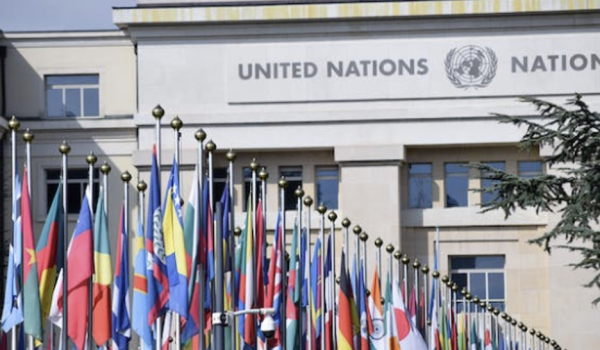Supporting learners in the most vulnerable contexts is urgent to ensure nobody is left behind. Education in Emergencies (EiE) raises awareness and emergencies. This article will explore what EiE means and which current priorities it aims to tackle.
When thinking of going to school, there may be some possible images coming to our minds: students waiting for a bus to take them to school, or maybe parents driving them there. Others take a walk or ride a bike and get there safely. Attending school is a regular activity in our lives, and getting a high school diploma or a college degree is part of our common life plans. Why do we do it? There are many possible reasons, but the most common one is to access more life opportunities. But, have you ever wondered if all children and teenagers around the world feel safe while going to school?
Some people have lived their entire lives, or have been exposed to, or even attempted to escape from, real hazards threatening their lives: natural disasters, social mass protests, deep economic crises, political instability, wars and extreme violence, armed conflicts, among others. Situations that we sadly see in the news regularly, awaken our empathy and desires to change the world. Did you know that education still takes place in such circumstances? And actually, education plays a life-saving role in such places. This is possible thanks to Education in Emergencies (EiE).
What is Education in Emergencies (EiE)?
The universal right to education aims to improve the life quality of all people around the globe, even during extreme crises, natural hazards, or social conflicts. Education in such moments is not only a valid way to provide humanitarian assistance. It is also an important way to protect affected children and youth from extremely violent environments and risk exposure, as well as to reduce the impact of learning gaps short and long term. EiE involves all levels of education for people exposed to humanitarian crises in different parts of the world. It aims to protect and ensure access to and continuity of high-quality education for the most marginalized communities, which are also the most affected during crises.
But unlike other models of education, EiE does not focus on getting high scores. Actually, in such circumstances, grades become irrelevant. EiE represents instead a means to recovery, quality education provides physical, psychosocial, and cognitive protection in order to sustain and save the lives of endangered learners. Through non-formal education, dignity and human rights are protected within physically and psychologically safe learning environments, where all the needs of the students are aimed to be fulfilled during the emergency. EiE happens even in very complex circumstances, such as forced early marriage, armed forces recruitment, migration crisis and displacement of refugees, wars and international conflicts, or organized crime. Education spreads life-saving information and strengthens critical survival skills and coping mechanisms.
In EiE, schools go beyond their function of formal learning. Schools became places where learners can attend and find a place to keep motivated, cultivate their mindsets and resilience, and develop their social and emotional skills. Humanitarian workers usually find schools an entry point for the provision of basic support in terms of protection, sanitation, nutrition, and health. Such a holistic relevance of EiE makes it an urgent matter for achieving many of the Sustainable Development Goals, as well as a core need for international cooperation, especially in developing countries with higher hazard risks.
Education, Humanitarian Assistance, and Social Justice
Despite the urgency of EiE to save lives and support the development of vulnerable communities in the higher-risk zones, this has been recently placed as a priority for multiple development assistance programs but has also been one of the less considered in the past decades. Under the European Commission’s 2015-2019, investments in EiE increased from one percent in 2015 to 10 percent by 2019, resulting in a total estimate of over €450 million for EiE in contexts of human mobility – specifically support of migrants and refugees in 59 countries.
Multilateral and bilateral funds have also been increasing for EiE affairs. An example of such contributions is the U.S. Agency for International Development (USAID), which supports programs in countries with high-impact emergency situations, such as South Sudan and Jordan. Among their efforts, USAID supports organizations of crucial leadership in EiE, such as the US Education in Crisis and Conflict Working Group, the UN’s Education Cannot Wait global fund, and the Inter-Agency Network for Education in Emergencies (INEE). This last one is so far the largest global network of donors, practitioners, and policymakers working on education in crisis and conflict-affected countries.
Nowadays, the INEE is one of the top leaders in the field and works actively in awareness, fieldwork, research, and policy advice for understanding and developing standards and regulations for responsible and high-quality EiE interventions in marginalized communities. One of their most important documents, the Minimum Standards for Education, compiles different commonly agreed and experience-based standards organized into five domains: Foundational Standards, Access and Learning Environment, Teaching and Learning, Teachers and Educational Professionals, and Education Policy. Such standards support fieldworkers, NGOs, educators, and stakeholders in recommendations and policies to ensure that every EiE project is well-planned with high responsibility, ensuring safeguarding and real impact on the territory.
To conclude, education is a human right that we must ensure all people have access to and continuity. Fostering EiE must be a priority in the development agenda for international cooperation investments, but also national policies to ensure learning does not stop are more necessary than ever before. Adequate preparation of humanitarian field workers and project managers is crucial to ensure that EiE interventions are safe and impactful in the lives of the communities target and that such experience supports the personal development of affected people. Schools are meant to receive the relevance they have, because, in extreme circumstances, they can become the only safe place some children and youth have to survive, get relief, and cultivate hope.
Photo: Dean Drobot/Shutterstock
You might also like:
Understanding the Link Between International Cooperation and Education
Support us!
All your donations will be used to pay the magazine’s journalists and to support the ongoing costs of maintaining the site.
Share this post
Interested in co-operating with us?
We are open to co-operation from writers and businesses alike. You can reach us on our email at [email protected]/[email protected] and we will get back to you as quick as we can.










